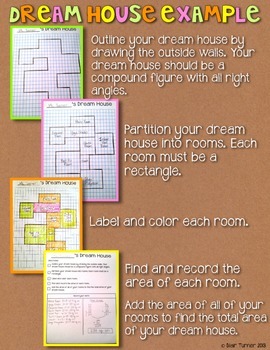Blair Turner
29.8k Followers
Grade Levels
3rd - 4th
Subjects
Resource Type
Standards
CCSS3.MD.C.7
CCSS3.MD.C.7d
CCSSMP4
Formats Included
- PDF
Pages
3 pages
Blair Turner
29.8k Followers
Description
This "Dream House" project is a super-fun way to attack additive area concepts. This resource is aligned with Common Core standards for grade 3, but would work well in any classroom that is exploring area.
Common Core Alignment:
CCSS.Math.Content.3.MD.C.7d Recognize area as additive. Find areas of rectilinear figures by decomposing them into non-overlapping rectangles and adding the areas of the non-overlapping parts, applying this technique to solve real world problems.
This fun freebie includes 3 pages:
•"Dream House" graph paper
•student directions/recording space
•photographs/examples for teacher and/or student reference
Your students will LOVE it and you will too - engaging, easy to prep, meaningful, fun and best of all - FREE!
•••••••••••••••••••••••••••••••••••••••••••••••••••••••••••••••••••••••••••••••••••••••
More area resources available in my store:
Interactive Notebook: 3rd Grade CCSS Measurement and Data Bundle
Interactive Notebook: Rectilinear Area Concepts {3.MD.7}
3rd Grade CCSS Task Cards: Measurement and Data
3rd Grade CCSS Math Assessments: Measurement and Data
Area and Perimeter Lesson: Farmer Peter's Pumpkin Patch
•••••••••••••••••••••••••••••••••••••••••••••••••••••••••••••••••••••••••••••••••••••••
© Blair Turner 2013
Materials are intended for personal use only.
Common Core Alignment:
CCSS.Math.Content.3.MD.C.7d Recognize area as additive. Find areas of rectilinear figures by decomposing them into non-overlapping rectangles and adding the areas of the non-overlapping parts, applying this technique to solve real world problems.
This fun freebie includes 3 pages:
•"Dream House" graph paper
•student directions/recording space
•photographs/examples for teacher and/or student reference
Your students will LOVE it and you will too - engaging, easy to prep, meaningful, fun and best of all - FREE!
•••••••••••••••••••••••••••••••••••••••••••••••••••••••••••••••••••••••••••••••••••••••
More area resources available in my store:
Interactive Notebook: 3rd Grade CCSS Measurement and Data Bundle
Interactive Notebook: Rectilinear Area Concepts {3.MD.7}
3rd Grade CCSS Task Cards: Measurement and Data
3rd Grade CCSS Math Assessments: Measurement and Data
Area and Perimeter Lesson: Farmer Peter's Pumpkin Patch
•••••••••••••••••••••••••••••••••••••••••••••••••••••••••••••••••••••••••••••••••••••••
© Blair Turner 2013
Materials are intended for personal use only.
Total Pages
3 pages
Answer Key
N/A
Teaching Duration
N/A
Report this resource to TPT
Reported resources will be reviewed by our team. Report this resource to let us know if this resource violates TPT’s content guidelines.
Standards
to see state-specific standards (only available in the US).
CCSS3.MD.C.7
Relate area to the operations of multiplication and addition.
CCSS3.MD.C.7d
Recognize area as additive. Find areas of rectilinear figures by decomposing them into non-overlapping rectangles and adding the areas of the non-overlapping parts, applying this technique to solve real world problems.
CCSSMP4
Model with mathematics. Mathematically proficient students can apply the mathematics they know to solve problems arising in everyday life, society, and the workplace. In early grades, this might be as simple as writing an addition equation to describe a situation. In middle grades, a student might apply proportional reasoning to plan a school event or analyze a problem in the community. By high school, a student might use geometry to solve a design problem or use a function to describe how one quantity of interest depends on another. Mathematically proficient students who can apply what they know are comfortable making assumptions and approximations to simplify a complicated situation, realizing that these may need revision later. They are able to identify important quantities in a practical situation and map their relationships using such tools as diagrams, two-way tables, graphs, flowcharts and formulas. They can analyze those relationships mathematically to draw conclusions. They routinely interpret their mathematical results in the context of the situation and reflect on whether the results make sense, possibly improving the model if it has not served its purpose.





